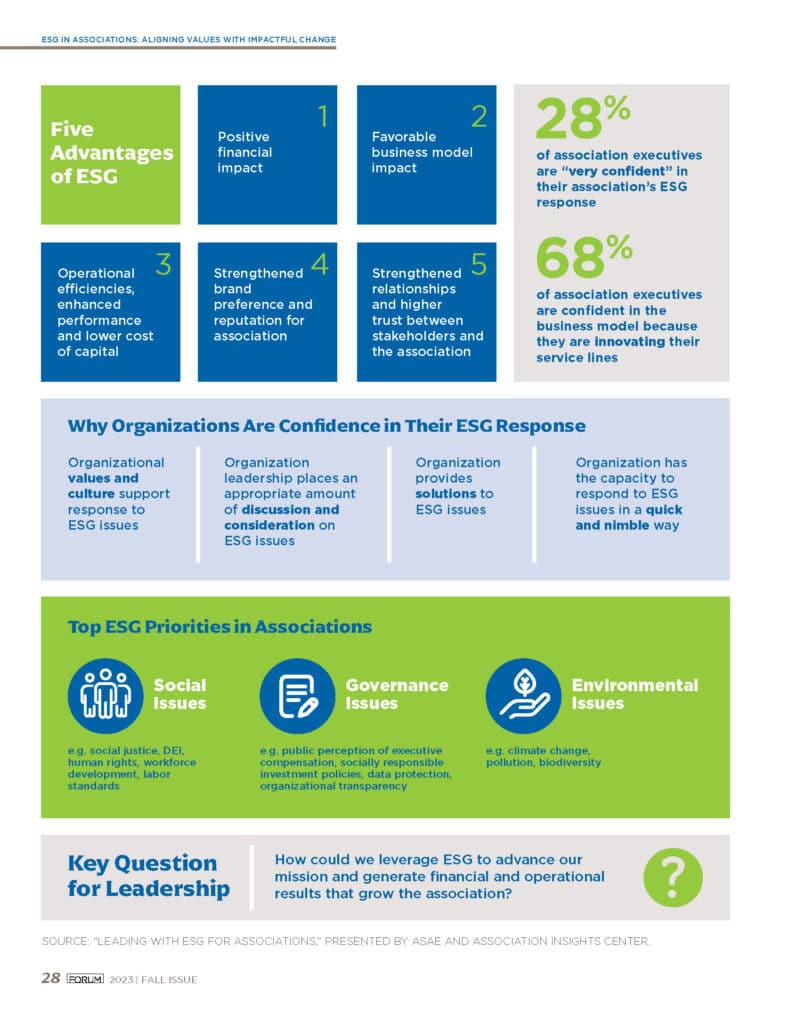ESG in Associations: Aligning Values with Impactful Change

The term ESG, standing for environmental, social, and governance, continues to evolve in the corporate world.
Historically, ESG focused on investment, a method to screen investments based on corporate policies and to encourage companies to act responsibly. However, these initiatives now often incorporate CSG (corporate, social, and governance) and sustainability.
An increasing number of associations are rethinking what ESG means for their members, boards of directors, leadership teams, and employees. To aid associations in navigating ESG complexities, the American Society of Association Executives (ASAE) developed the Association Insights Center. With the help of strategic partners, including Association Forum, the center provides on-demand intelligence and tools to support association leadership teams.
Additionally, ASAE conducted a survey of 165 association executives and found that while many associations have taken initial steps towards addressing ESG, several have deeply ingrained programs that integrate ESG into their business models. The survey revealed that association leaders view social issues as the top ESG priority. Topics addressed include diversity, equity, inclusion, justice, accessibility, equal access, human rights, labor standards, social justice, sourcing, organizational culture, and workforce development.
Patrick Glaser, Chief Practice Officer at McKinley Advisors, stated that there are numerous unique examples of how associations are approaching the social aspect of ESG. Some associations begin with clear diversity statements, incorporating them into their missions, leadership diversity, and recruitment policies. Others are developing programs to enhance and facilitate membership diversity, providing confidence to teach their members inclusivity. Associations are also developing policies on responding to arising social issues and addressing workforce burnout.
Associations that are focusing on the environmental component of ESG often have ties to the environment. Some are identifying the amount of carbon emissions emitted from travel to meetings and exploring offset options. Others are thinking about the pollution their industry is producing, measuring a specific field’s toll, and seeking solutions.
For those who are looking at the governance issue, some associations are focusing on transparency, publishing leaders and staff salaries. Others are rethinking where they are investing their reserves and focusing on ESG investments.
A Closer Look
While ESG is on the radar of many associations, most established ESG policies are found in large associations, mainly due to increased stakeholder pressure and resource availability.
The American Industrial Hygiene Association (AIHA), is an association for scientists and professionals committed to preserving and ensuring occupational and environmental health and safety (OEHS). AIHA recently established ESG guidelines in line with their mission. The AIHA leadership team is taking a proactive approach to educating its 8,000 members about the growing scope of human capital (HC) and ESG initiatives and the impact they have on the OEHS profession.
AIHA has included human capital as an area of focus as OEHS professionals are committed to the environmental health and well-being of workers.
“This is front and center to AIHA’s mission,” said Charles Redinger, Chair, Human Capital/ESG Task Force, AIHA. “Our profession falls under ESG’s ‘S’ category, and our focus is around human capital within the workplace. We formed the Human Capital/ESG committee to impact standards development and to look internally to help educate the members and the profession. The Guidance document was the first piece of that.”
According to the AIHA HC/ESG Guidance Document, traditional environmental health and safety issues remain top concerns for industrial organizations implementing ESG reporting. According to a survey by PwC (PricewaterhouseCoopers), “ensuring worker health and safety” is the second most cited ESG issue for companies, behind only reducing greenhouse gas emissions (Chalmers et al., 2021).
Due to the importance of ESG in the OEHS profession, AIHA formed the HC/ESG Task Force to develop the HC/ESG Guidance Document. This tool aids the OEHS practitioners in understanding the HC/ESG fundamentals and their increasing involvement in sustainability/ESG measurement and reporting of OHS metrics. In addition to providing strategic direction, the Guidance Document includes an overview of key terminology, organizations,and evolving standards.
It highlights standards that include occupational health and safety (OHS)-related requirements and guidance. Beyond HC/ESG fundamentals, AIHA’s HC/ESG Task Force chose to focus on baseline metrics. This is because metrics play a central role in disclosures and reporting.
Challenges of ESG
Navigating ESG is not without challenges. According to Glaser, one of the biggest challenges is that ESG is a very broad grouping of topics. Associations need to determine which areas align with their mission and justify spending resources.
Additionally, there is increasing nationwide pushback against ESG. Many association execs find it challenging to pursue developing ESG initiatives due to the polarization of ESG issues. It is a divisive and often heated issue that winds up being debated among politicians and in the court of public opinion. While many association leaders are taking steps to integrate ESG programming, they are also apprehensive because of the potential negative publicity or legal consequences with reporting related to ESG. According to the Harvard Law School Forum on Corporate Governance, U.S. securities law and SEC regulations make issuer statements to investors actionable, therefore opening issuers to liability in their ESG disclosures.
Getting Started
If your organization is a member of ASAE’s Association Insights Center, we highly recommend leveraging those ESG resources. If not, you can still begin to move the needle for ESG within your association. Consider the following steps to start your journey:
- Determine if your organization aligns with the E, S, or G in ESG.
- Review your organization’s mission to determine appropriate ties to ESG.
- Form a committee.
- Develop metrics.
- Determine audiences.
- Educate members and external audiences on your organization’s
ESG work.
We’d love to hear about your association’s ESG journey in our MyForum community! Let us know what your group has been up to and reference this article in your post.
Tags
Related Articles
The Champion’s Mindset: What Elite Athletes Can Teach Us About Mental Toughness and Success
An interview with Dr. Wendy Borlabi, sport psychologist and closing keynote speaker for Women’s Executive...
Great Bosses, Greater Impact: Leadership Lessons that Stick
The best bosses leave more than instructions—they leave echoes of confidence, creativity, and leadership that...
The Secret to Building a Strong, Reliable Professional Network
Authenticity, shared vulnerability, and common interests are the keys to creating a network that truly...





